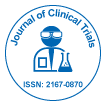
Journal of Clinical Trials
Open Access
ISSN: 2167-0870

ISSN: 2167-0870
Commentary - (2025)Volume 15, Issue 4
Preeclampsia remains a significant contributor to maternal and perinatal morbidity and mortality worldwide, particularly in low-resource settings. Characterized by new-onset hypertension and proteinuria after 20 weeks of gestation, preeclampsia is associated with adverse outcomes including preterm birth, placental abruption, fetal growth restriction and maternal organ dysfunction. Preventive strategies are limited, but low-dose aspirin has shown promise in observational studies and smaller trials. This randomized, double-blind controlled trial aimed to evaluate the efficacy and safety of initiating low-dose aspirin in early pregnancy for the prevention of preeclampsia among women identified as high risk.
The study was conducted across eight tertiary obstetric centers. A total of 1,540 pregnant women were enrolled between 11 and 14 weeks of gestation, all of whom met the inclusion criteria based on clinical risk factors. These included prior history of preeclampsia, chronic hypertension, type 1 or 2 diabetes, renal disease, autoimmune conditions, or multifetal pregnancy. Participants were randomized in a 1:1 ratio to receive either 150 mg of aspirin or placebo daily at bedtime until 36 weeks of gestation or delivery, whichever came first.
Baseline demographics were comparable between the two groups. The average maternal age was 29 years and the majority were nulliparous. Blood pressure, body mass index and biochemical markers including serum creatinine and baseline platelet counts were recorded at enrollment. Follow-up visits were scheduled monthly until 28 weeks and biweekly thereafter, with standardized protocols for measuring blood pressure and testing for proteinuria.
The primary endpoint was incidence of preeclampsia, defined using the criteria established by the International Society for the Study of Hypertension in Pregnancy. Secondary outcomes included gestational age at delivery, birth weight, incidence of fetal growth restriction, placental abruption, Neonatal Intensive Care Unit (NICU) admission and any maternal bleeding complications. All outcomes were adjudicated by an independent review committee blinded to group assignment.
In the final analysis, the incidence of preeclampsia was significantly lower in the aspirin group (9.6%) compared to the placebo group (15.3%). The relative risk reduction was most pronounced among women with prior early-onset preeclampsia or those with chronic hypertension. The mean gestational age at delivery was 38.2 weeks in the aspirin group compared to 36.9 weeks in the placebo group. Additionally, rates of preterm delivery before 34 weeks were significantly lower in the intervention group.
Birth weights were higher in the aspirin group and the proportion of neonates classified as small for gestational age was reduced by nearly 30%. NICU admission rates were lower among neonates born to women in the aspirin group, with improved Apgar scores and fewer respiratory complications. Placental pathology in a subset of deliveries showed better vascular remodeling and fewer features of ischemic damage in the aspirin group.
Maternal safety was carefully monitored throughout the trial. There was no significant difference in rates of antepartum or postpartum hemorrhage between groups. Platelet counts and liver enzymes remained within normal limits in both groups across all measured time points. Compliance with aspirin intake was high, with more than 85% adherence confirmed through pill counts and patient diaries.
Subgroup analysis revealed that the benefit of aspirin was consistent across age groups, parity and comorbidity profiles, although the effect size was larger among women with a previous history of hypertensive pregnancy complications. The timing of initiation appeared to be important, with participants who began aspirin before 13 weeks showing better outcomes than those who began slightly later.
The trial also evaluated patient perceptions and tolerance of aspirin use during pregnancy. Most participants in the aspirin group reported no side effects and expressed willingness to continue use in future pregnancies if recommended. A few participants reported mild gastrointestinal discomfort, but these symptoms did not require discontinuation of therapy.
This trial demonstrated that low-dose aspirin, when initiated early in pregnancy and continued until late third trimester, can significantly reduce the risk of preeclampsia and associated complications in high-risk women. The findings align with prior meta-analyses but provide more definitive evidence from a well-powered, multicenter study. Importantly, the intervention was both simple to implement and well-tolerated.
The mechanism by which aspirin may prevent preeclampsia likely involves inhibition of platelet aggregation and modulation of thromboxane-prostacyclin balance, improving placental perfusion and reducing endothelial dysfunction. Although these pathways were not directly assessed in this study, the observed clinical benefits support their potential relevance.
In conclusion, this double-blind randomized trial provides strong evidence that early initiation of low-dose aspirin significantly reduces the risk of preeclampsia and improves maternal and neonatal outcomes among high-risk pregnancies. The favorable safety profile, accessibility and ease of administration support the incorporation of low-dose aspirin into antenatal care protocols for appropriately selected patients. Further research may help refine the optimal dose and identify additional populations that could benefit from this preventive strategy. These results add to the growing body of literature supporting proactive, individualized approaches to managing hypertensive disorders in pregnancy.
Citation: Flower R (2025). A Double-Blind Trial Assessing Low-Dose Aspirin in Prevention of Preeclampsia in High-Risk Pregnancies. Clin Trials. 15:593.
Received: 06-Jun-2025, Manuscript No. JCTR-25-37922; Editor assigned: 09-Jun-2025, Pre QC No. JCTR-25-37922 (PQ); Reviewed: 23-Jun-2025, QC No. JCTR-25-37922; Revised: 30-Jun-2025, Manuscript No. JCTR-25-37922 (R); Published: 07-Jul-2025 , DOI: 10.35248/2167-0870.25.15.593
Copyright: © 2025 Flower R. This is an open-access article distributed under the terms of the Creative Commons Attribution License, which permits unrestricted use, distribution and reproduction in any medium, provided the original author and source are credited.